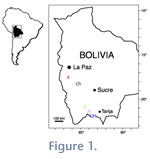Introduction
The middle Miocene fossil mammal record of Bolivia is incredibly rich, yet numerous localities have received little detailed investigation. Due to its central position in South America, Bolivia today is an important biogeographical transition area that encompasses varied ecozones (Altiplano, Amazon rainforest, Andean range, and Chaco) that shelter a great deal of biodiversity. In the past, Bolivia and other middle latitude areas may have been a center of diversity and/or origin for certain mammal groups including mesotheriid notoungulates (Marshall and Sempere 1991;
Flynn and Wyss 1998;
Cerdeño and Montalvo 2001;
Croft et al. 2004,
2007,
2008;
Flynn et al. 2005;
Croft and Anaya 2006;
Croft 2007).
Among notoungulates, mesotheriids are grouped within the suborder Typotheria, though their precise relationships within that clade are unclear (Simpson 1945;
Cifelli 1993;
Croft et al. 2004;
Reguero and Castro 2004;
Billet et al. 2008). Most typotheres are small notoungulates (< 10 kg;
Elissamburu 2004) and are usually described as filling the small herbivore niche of modern rabbits, rodents, and small ungulates (Simpson 1967;
Patterson and Pascual 1968;
Cifelli 1985;
Croft 1999;
Croft et al. 2003). Mesotheriids were among the largest of typotheres and were likely semi-fossorial or fossorial (Shockey et al. 2007).
 In Bolivia, mesotheriids are present in late Oligocene through late Miocene deposits throughout the Altiplano (Hoffstetter et al. 1972;
Villarroel 1974a,
1974b,
1978;
Hoffstetter 1986;
Marshall and Sempere 1991;
Oiso 1991;
Marshall et al. 1992;
Flynn and Swisher 1995;
MacFadden et al. 1995;
Hérail et al. 1996;
Flynn et al. 2002;
Croft et al. 2004,
2007;
Croft 2007;
Billet et al. 2008). Many of these occurrences pertain to Plesiotypotherium, a taxon first described from Achiri (Villarroel 1974a) and subsequently identified in other localities (Villarroel 1978;
Oiso 1991;
Croft 2007). Three species of Plesiotypotherium are currently recognized, two larger forms from Achiri (P. achiriense and P. majus) and a smaller one from Cerdas (P. minus; see below) (Figure 1). The generic status of P. minus has been unclear because it was diagnosed primarily on its small size rather and lack of derived character states. The species predates other members of the genus by some five million years.
In Bolivia, mesotheriids are present in late Oligocene through late Miocene deposits throughout the Altiplano (Hoffstetter et al. 1972;
Villarroel 1974a,
1974b,
1978;
Hoffstetter 1986;
Marshall and Sempere 1991;
Oiso 1991;
Marshall et al. 1992;
Flynn and Swisher 1995;
MacFadden et al. 1995;
Hérail et al. 1996;
Flynn et al. 2002;
Croft et al. 2004,
2007;
Croft 2007;
Billet et al. 2008). Many of these occurrences pertain to Plesiotypotherium, a taxon first described from Achiri (Villarroel 1974a) and subsequently identified in other localities (Villarroel 1978;
Oiso 1991;
Croft 2007). Three species of Plesiotypotherium are currently recognized, two larger forms from Achiri (P. achiriense and P. majus) and a smaller one from Cerdas (P. minus; see below) (Figure 1). The generic status of P. minus has been unclear because it was diagnosed primarily on its small size rather and lack of derived character states. The species predates other members of the genus by some five million years.
In 1991, a team from the Florida Museum of Natural History recovered a large sample of mesotheriine craniodental material from Cerdas (MacFadden et al. 1995). Presumably because the holotype of P. minus had been collected from the same general area as these specimens, most were referred to P. minus, including a well-preserved cranium; no detailed descriptions of the specimens were provided. The purpose of the present study is to: 1) describe the skull and other dental material collected from Cerdas in 1991 (supplemented by data from other collections; see below); and 2) evaluate the taxonomic validity of P. minus using these new specimens and data from other middle latitude mesotheriines from Chile and Bolivia (Table 1).
The Cerdas locality is situated in southern Bolivia about 60 km southeast of the city of Uyuni (21° 52' S, 66° 18-19' W;
Villarroel 1978;
MacFadden et al. 1995). Based on the "more specialized" morphology of P. minus relative to Microtypotherium,
Marshall and Sempere (1991, p. 637) suggested the fauna might pertain to the Chasicoan SALMA (late Miocene). Subsequent radiometric dates and paleomagnetic correlations have demonstrated that Cerdas is considerably older (early middle Miocene, between 16.35 and 15.1 Ma;
MacFadden et al. 1995), potentially corresponding to the Friasian SALMA sensu stricto (Flynn and Swisher 1995). Little has been published on the fauna collected at Cerdas—other than P. minus, only the small mesotheriine Microtypotherium cf. choquecotense and a specimen of Plesiotypotherium cf. achirense have been reported (Villarroel 1978)—though investigations based on recent collecting efforts are currently underway (Croft et al. 2009).